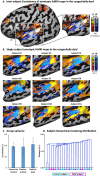Topographical functional connectivity patterns exist in the congenitally, prelingually deaf
- PMID: 27427158
- PMCID: PMC4947901
- DOI: 10.1038/srep29375
Topographical functional connectivity patterns exist in the congenitally, prelingually deaf
Abstract
Congenital deafness causes large changes in the auditory cortex structure and function, such that without early childhood cochlear-implant, profoundly deaf children do not develop intact, high-level, auditory functions. But how is auditory cortex organization affected by congenital, prelingual, and long standing deafness? Does the large-scale topographical organization of the auditory cortex develop in people deaf from birth? And is it retained despite cross-modal plasticity? We identified, using fMRI, topographic tonotopy-based functional connectivity (FC) structure in humans in the core auditory cortex, its extending tonotopic gradients in the belt and even beyond that. These regions show similar FC structure in the congenitally deaf throughout the auditory cortex, including in the language areas. The topographic FC pattern can be identified reliably in the vast majority of the deaf, at the single subject level, despite the absence of hearing-aid use and poor oral language skills. These findings suggest that large-scale tonotopic-based FC does not require sensory experience to develop, and is retained despite life-long auditory deprivation and cross-modal plasticity. Furthermore, as the topographic FC is retained to varying degrees among the deaf subjects, it may serve to predict the potential for auditory rehabilitation using cochlear implants in individual subjects.
Figures


References
-
- Stevens G. et al.. Global And Regional Hearing Impairment Prevalence: An Analysis Of 42 Studies In 29 Countries. Eur J Public Health. 23, 146–52 (2011). - PubMed
-
- Kral A. Auditory Critical Periods: A Review From System’s Perspective. Neuroscience. 247, 117–33 (2013). - PubMed
-
- Gordon K. A. et al.. Use It Or Lose It? Lessons Learned From The Developing Brains Of Children Who Are Deaf And Use Cochlear Implants To Hear. Brain Topogr. 24, 204–19 (2011). - PubMed
Publication types
MeSH terms
LinkOut - more resources
Full Text Sources
Other Literature Sources
Medical

